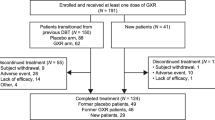Abstract
Introduction
Guanfacine, an alpha-2 adrenergic agonist, is used to treat attention deficit hyperactivity disorder (ADHD). Although cardiovascular effects including hypotension and bradycardia are common adverse effects of guanfacine, the effect of guanfacine on QT intervals remains unclear. The association between the serum concentration of guanfacine and its toxicity has also not been fully investigated.
Case Report
This is a case of a 21-year-old woman with ADHD who developed repeated presyncope 1 day before admission. She was taking 3 mg of extended-release guanfacine and 50 mg of sertraline. On admission, she had bradycardia and hypotension. An electrocardiogram (ECG) showed a QT interval of 0.68 s and a QTcF interval of 0.648 s. The QT intervals were manually measured and corrected by the Fridericia formula (QTcF = QT/RR1/3). Although she denied taking an overdose of guanfacine and other drugs, we suspected guanfacine toxicity. The serum guanfacine concentration was 13.0 ng/mL on admission and decreased to 3.2 ng/mL on day 1 and 0.4 ng/mL on day 2. Changes in QTcF intervals and her vital signs correlated with serum guanfacine concentrations.
Conclusion
Supratherapeutic serum guanfacine concentrations may induce QT prolongation.


Similar content being viewed by others
Data Availability
This is a case report, all data are in the manuscript.
References
Winograd EJ, Sollee D, Schauben JL, Kunisaki T, Smotherman C, Gautam S. Pediatric guanfacine exposures reported to the National Poison Data System, 2000–2016. Clin Toxicol. 2020;58:49–55.
Bridwell RE, Larson NP, Rosenthal JB, Wray J, Baker Z, Cibrario A, et al. Guanfacine toxic ingestion with subsequent cardiogenic pulmonary edema. Am J Emerg Med. 2021;39:256.e5-256.e8.
Martinez-Raga J, Knecht C, Szerman N, Martinez MI. Risk of serious cardiovascular problems with medications for attention-deficit hyperactivity disorder. CNS Drugs. 2013;27:15–30.
Martin P, Satin L, Kahn RS, Robinson A, Corcoran M, Purkayastha J, et al. A thorough QT study of guanfacine. Int J Clin Pharmacol Ther. 2014;53:301–16.
Schulz M, Schmoldt A, Andresen-Streichert H, Iwersen-Bergmann S. Revisited: therapeutic and toxic blood concentrations of more than 1100 drugs and other xenobiotics. Crit Care. 2020;24:195.
Tsuda Y, Matsuo Y, Matsumoto S, Wajima T. Population pharmacokinetic and exposure-response analyses of guanfacine in Japanese pediatric ADHD patients. Drug Metab Pharmacokinet. 2019;34:365–71.
Fein DM, Hafeez ZF, Cavagnaro C. An overdose of extended-release guanfacine. Pediatr Emerg Care. 2013;29:929–31.
Spiller HA, Hays HL, Aleguas A. Overdose of drugs for attention-deficit hyperactivity disorder: clinical presentation, mechanisms of toxicity, and management. CNS Drugs. 2013;27:531–43.
Minns AB, Clark RF, Schneir A. Guanfacine overdose resulting in initial hypertension and subsequent delayed, persistent orthostatic hypotension. Clin Toxicol. 2010;48:146–8.
Calculator.net. https://www.calculator.net/half-life-calculator.html. Accessed 18 Sept 2023.
Zhang L, Timothy KW, Vincent GM, Lehmann MH, Fox J, Giuli LC, et al. Spectrum of ST-T-wave patterns and repolarization parameters in congenital long-QT syndrome: ECG findings identify genotypes. Circulation. 2000;102:2849–55.
Acknowledgements
We are grateful to our department of clinical laboratory for preserving the serum samples until examination of the drug concentrations.
Funding
None.
Author information
Authors and Affiliations
Corresponding author
Ethics declarations
Ethical Approval
Consent for publication of this case was obtained and provided to the journal in accordance with JMT policy.
Conflicts of Interest
None.
Additional information
Supervising Editor: Andis Graudins, MB BS, PhD
Publisher's Note
Springer Nature remains neutral with regard to jurisdictional claims in published maps and institutional affiliations.
Rights and permissions
Springer Nature or its licensor (e.g. a society or other partner) holds exclusive rights to this article under a publishing agreement with the author(s) or other rightsholder(s); author self-archiving of the accepted manuscript version of this article is solely governed by the terms of such publishing agreement and applicable law.
About this article
Cite this article
Inoue, F., Okazaki, Y., Kashiwa, K. et al. QT-Interval Prolongation Associated with Supratherapeutic Guanfacine Concentration: A Case Report. J. Med. Toxicol. 20, 218–221 (2024). https://doi.org/10.1007/s13181-023-00986-8
Received:
Revised:
Accepted:
Published:
Issue Date:
DOI: https://doi.org/10.1007/s13181-023-00986-8




